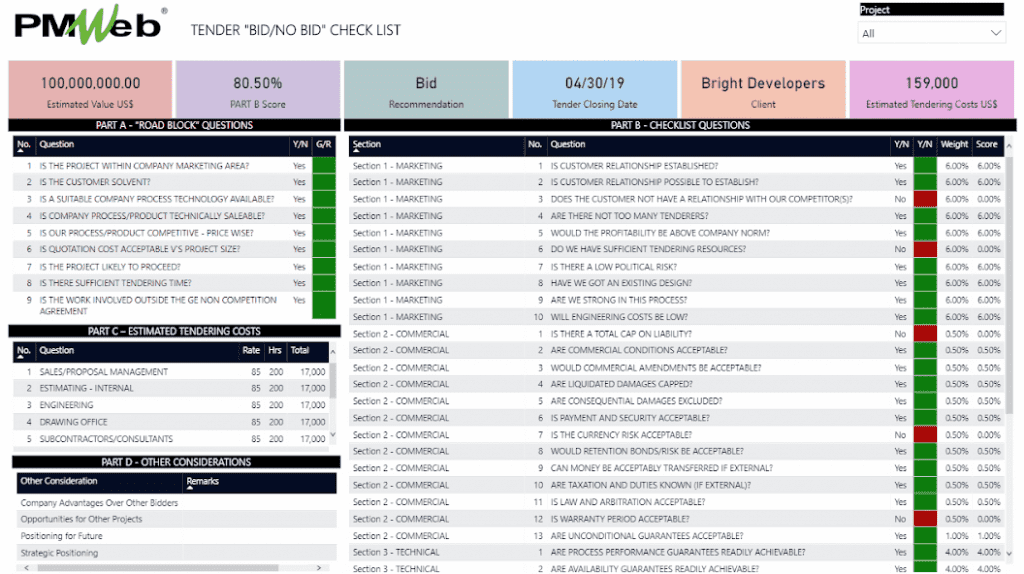“To bid, or not to bid, that is the question.”
A bid/no-bid decision process is a formal, rational process a contractor should undertake in order to determine whether to proceed in preparing a bid and submitting the bid or a no-bid letter in response to an invitation for bids (IFB) or a request for proposal (RFP) sent by a soliciting organization.
Contractors could invest a great deal of time and resources into putting together a bid, so it’s important to make sure that they are carefully identifying the right projects to go after. One way to do this is by conducting a thorough bid/no-bid analysis that meets your company’s goals and is in line with your long-term strategy.
Using Project Management Information Systems (PMIS) like PMWeb will enable organizations to formalize the “Bid/ No Bid” recommendation and decision process. The first step will be to create a new project for the opportunity identified by the sales or business development team. The PMWeb project module will be used to capture details of the project name, location, estimated budget, estimate start and finish dates, project description, project owner, engineering consultant and other important project details needed for the Bid/No Bid recommendation. The information for the project stakeholders and others will be available to select from predefined list of values that is relevant to the organization’s project’s business.

Next step will be to use PMWeb custom form builder to create the Bid/No Bid Recommendation form which will become the default form template to be used on all bid opportunities. The form will capture additional needed fields of invitation for bids (IFB) or a request for proposal (RFP) such as the bid closing date among others. It should be noted that most of the opportunity’s general information was already captured in the project form created above. The form will also include a couple of checklist tables. The first checklist will be known as the “ROAD BLOCK” questions. Any “NO” response to the “Road Block” questions shall indicate that no further work shall be done on this job and no bid is to be submitted. Only if “Road Block” Questions are all “Yes”, then the form transmitter, also known as tender proposer, can proceed to Part B of the Checklist Questions.

The second checklist, titled as “PART B – CHECKLIST QUESTIONS,” will have different sections including Marketing, Commercial, Administrative and Contract Resources and Cultural. Every question in each section must be answered. Each question has a predefined weight score that will be calculated and presented in the output report. The total score obtained from Part B of the Checklist Questions is an indication of the relative viability of tendering on a particular project.

Following the establishment of Project viability from Parts A and B, the form transmitter will examine the project specification sufficient to enable completion of Part C for estimated tendering costs. For significant tenders, the form transmitter will obtain estimates from supporting Departments/Divisions, as appropriate, prior to completion of Part C.

If required, the form transmitter needs to complete Part D and elaborate on “Other” issues to be considered (i.e. Strategic positioning, company advantages over other bidders, positioning for future, opportunities for other projects, etc.) that is relevant in determining a BID or NO BID decision.

The attachment tab for the “Bid/No Bid Recommendation” form will be used to upload all relevant documents such as the invitation to bid or request for proposal along with other documents that were used to support the tender proposer response to the checklist questions. All those documents will be uploaded and stored on PMWeb document management repository.

The “Bid/No Bid Recommendation” form workflow will be used to map the different approval levels needed to make the final recommendation to Bid or No Bid. In case there will be different team members assigned to complete the different checklists, the workflow steps can be mapped to those tables to set the right access levels.

Finally, once the form is completed and approved by the proposer as per the predefined workflow, a report will be generated using PMWeb to capture and present all the results of the bid/no bid checklist response. The form will show the response to the “PART A- ROAD BLOCK” questions to ensure that they were all “YES” and which will have a “GREEN” color indicator. The form will also include the response to all questions for each section of “PART B- CHECKLIST QUESTIONS”. The response table will highlight all those question with “YES” response which will have a “GREEN” indicator and those questions with “NO” response which will have a “RED” indicator. The “PART B- CHECKLIST QUESTIONS” will also include the weight and score value for each question. The “TENDER BID/NO BID” checklist report will become the basis for discussion and agreement with the Sales Manager to proceed with the proposal preparation or not.

The response to “PART B- CHECKLIST QUESTIONS” can also be visually presented to review the available weight for each section of this part and the earned score for each based on the questions reponse. The report will include two main visuals. The first to show the total number of questions within each sector and how many of those were answered as “YES,” while the second visual will be to show the total weight available for each section and the response score earned for each.




